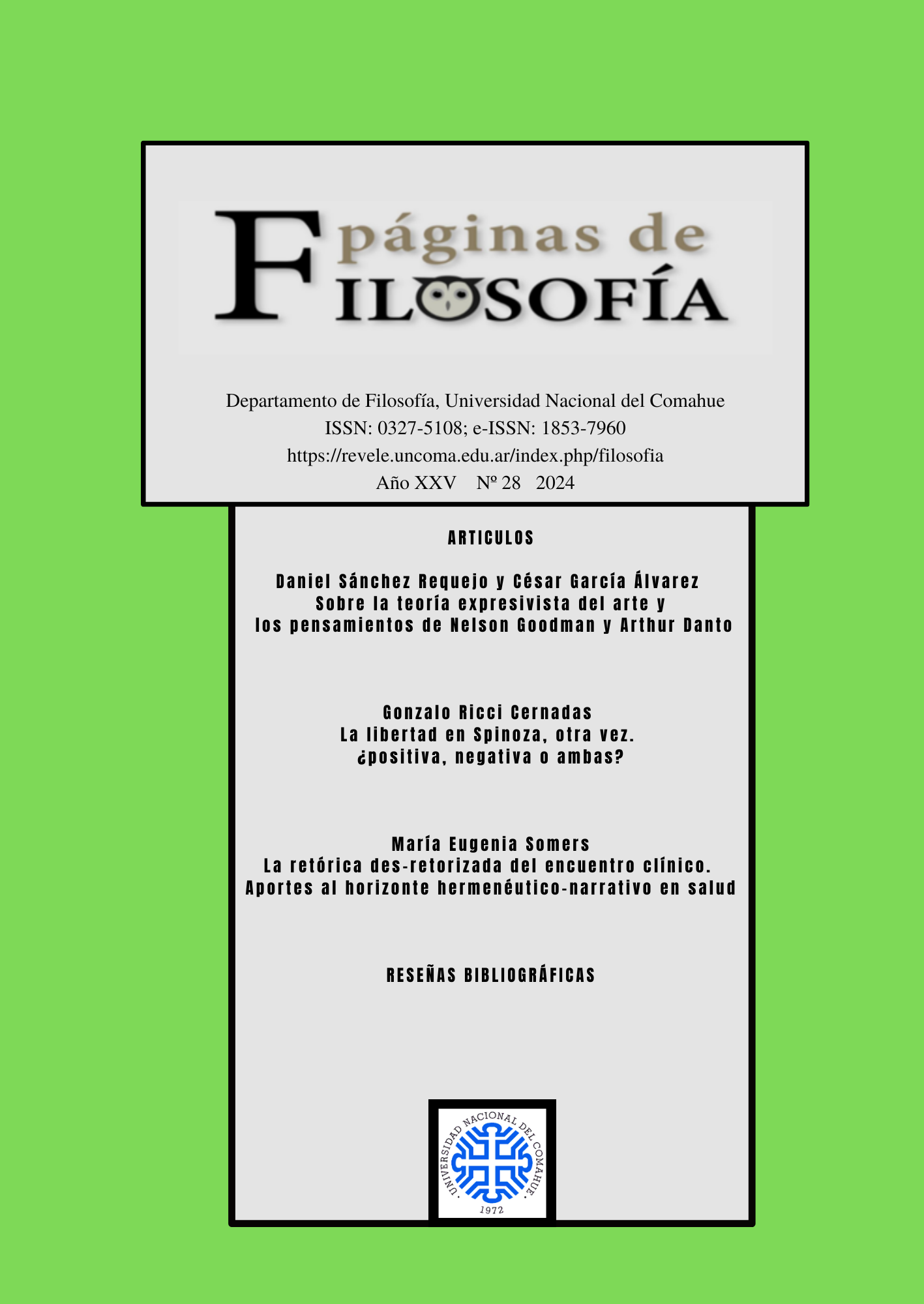The de-rhetorized rhetoric of the clinical Encounter. Contributions to the hermeneutic- Narrative horizon in health
Keywords:
Text, Clinical encounter, Hermeneutics, Narrative, RhetoricAbstract
In response to an increasingly specialized, technologized and scientificist clinical practice, medicine and bioethics seek to restore the protagonism of the patient's experience. To this end, an increasing number of sectors within medicine and bioethics are adopting a theoretical framework from the hermeneutic tradition or the narrative turn. Physiological symptoms and laboratory results are no longer interpreted alone: by incorporating the patient's voice, the aim is to consider the patient as a whole, as a text to be understood. However, the heterogeneous reception of these perspectives hinders the feedback between theories. Those that emphasize the narrative aspect reveal an underlying dualism between the body and the patient, the technical and interlocutive capacities of professionals, and the scientific and the narratable, and those that emphasize the hermeneutic aspect have inconveniences when it comes to arguing for the application of theory to life. In this paper, it is argued that the rhetorical dimension needs to be incorporated into the hermeneutic-narrative theoretical horizon in medicine and bioethics. It is hoped that this paper will constitute a contribution to the “unsaid” in the definitions that health specialists use of narrative, hermeneutics and, of course, text.
Downloads
References
Bianchi, E., Seijas, C. y Fiamberti, A. C. (2021), “Diagnósticos y más allá: Tiempos, cuidados y maternidad en mujeres-madres de niños, niñas y adolescentes con diagnóstico en salud mental (Ciudad de Buenos Aires, 2018)”, Cuestiones de Sociología, volumen 25, agosto 2021, 1-19. Recuperado el 01 de mayo de 2024 de: https://doi.org/10.24215/23468904e122
Charalambous A. (2010), “Interpreting patients as a means of clinical practice: introducing nursing hermeneutics”, International Journal of Nursing Studies, volumen 47, número 10, octubre de 2010, 1283-1291. Recuperado el 25 de abril de 2024 de: https://doi.org/10.1016/j.ijnurstu.2010.02.011
Charon, R. et al. (2017), The Principles and Practice of Narrative Medicine, New York, Oxford University Press.
Daniel, S.L. (1986), “The patient as text: A model of clinical hermeneutics”, Theor Med Bioeth, volumen 7, número 2, junio de 1986, 195-210. Recuperado el 31 de julio de 2022 de: https://doi.org/10.1007/BF00489230
Domingo Moratalla, T. (2007), “Bioética y hermenéutica. La aportación de Paul Ricoeur a la bioética” Veritas, Revista de Filosofía y Teología, volumen II, número 17, septiembre 2007, 281-312. Recuperado el 29 de julio de 2022 de: https://www.redalyc.org/articulo.oa?id=291122924005
Fabbri, P. y Latour, B. (1977), “La retórica de la ciencia: poder y deber en un artículo de ciencia exacta” en Fabbri, P. (2001 [1995]) Tácticas de los signos. Ensayos de semiótica, Escudero, L. (selección), Barcelona, Gedisa Editorial, 265-289.
Feito Grande, L. (2013), “Bioética narrativa”, Butlletí del Comité de Bioética de Catalunya, número 9, febrero de 2013, 1-7.
Frye, N. (1991[1957]), Anatomía de la crítica, Caracas, Monte Ávila Editores.
Gadamer, H-G. (1967), “Retórica, hermenéutica y crítica de la ideología. Comentarios metacríticos a Verdad y método I” en Gadamer, H-G. (1998 [1986]) Verdad y método II. Olasagasti, M. (trad.), Salamanca, Sígueme, 225-241.
Gadamer, H-G. (1971), “Réplica a Hermenéutica y crítica de la ideología” en Gadamer, H-G. (1998 [1986]) Verdad y método II. Olasagasti, M. (trad.), Salamanca, Sígueme, 243-265.
Gadamer, H-G. (1976a), “Retórica y hermenéutica” en Gadamer, H-G. (1998 [1986]) Verdad y método II. Olasagasti, M. (trad.), Salamanca, Sígueme, 267-281.
Gadamer, H-G. (1976b), “¿Lógica o retórica? De nuevo sobre la historia primitiva de la hermenéutica” en Gadamer, H-G. (1998 [1986]) Verdad y método II. Olasagasti, M. (trad.), Salamanca, Sígueme, 283-291.
Gadamer, H-G. (1978), “La hermenéutica como tarea teórica y práctica” en Gadamer, H-G. (1998 [1986]) Verdad y método II. Olasagasti, M. (trad.), Salamanca, Sígueme, 293-308.
Gadamer, H-G. (1999 [1960]), Verdad y método I, Agud Aparicio, A. y de Agapinto, R. (trad.), Salamanca, Sígueme.
Halsema, A. y Slatman, J. (2017), “The second-person perspective in narrative phenomenology” en H. Fielding, & D. Olkowski (edit.), Feminist Phenomenology Futures, Indiana, Indiana University Press, 243-256.
Jutel, A. (2009), “Sociology of diagnosis: a preliminary review”, Sociology of Health & Illness, volumen 31, número 2, abril de 2009, 278-299. Recuperado el 07 de octubre de 2022 de: https://doi.org/10.1111/j.1467-9566.2008.01152.x
Jutel, A. (2014 [2011]), Putting a Name to it. Diagnosis in contemporary society, Baltimore, Johns Hopkins University Press.
Kottow, M. (2016), “¿Bioética narrativa o narrativa bioética?”, Revista Latinoamericana de Bioética, volumen 16, número 2, abril de 2016, 58-69. Recuperado el 29 de julio de 2022 de: http://dx.doi.org/10.18359/rlbi.1763
Leder, D. (1990), “Clinical interpretation: The hermeneutics of medicine”, Theor Med Bioeth, volumen 11, número 1, marzo de 1990, 9–24. Recuperado el 29 de julio de 2022 de: https://doi.org/10.1007/BF00489234
Malterud, K. (1993), “Strategies for Empowering Women’s Voices in the Medical Culture.” Health Care for Women International, número 14, 365-73.
Menéndez, E. (1990), “El Modelo Médico Hegemónico. Estructura, función y crisis”, Morir de alcohol. Saber y hegemonía médica, México D.F., Alianza Editorial Mexicana, 83-117.
Merleau Ponty, M. (1985 [1945]), “El cuerpo como objeto y la fisiología mecanicista”, Fenomenología de la percepción, Cabanes, J. (trad.), Barcelona, Planeta-Agostini, 92-107.
Ricoeur, P. (2002 [1986]), Del texto a la acción. Ensayos de hermenéutica II, Corona, P. (trad.), México, Fondo de Cultura Económica.
Ricoeur, P. (2006a [1990]), Sí mismo como otro, México, Siglo XXI editores.
Ricoeur, P. (2006b [1976]), Teoría de la interpretación: Discurso y excedente de sentido, Monges Nicolau, G. (trad.), México, Siglo XXI editores.
Ricoeur, P. (2008 [2001]), Lo justo 2. Estudios, lecturas y ejercicios de ética aplicada, Domingo Moratalla, T. y Domingo Moratalla, A. (trad.), Madrid, Editorial Trotta.
Rosas Jiménez, C. A. (2014), “El paciente como ‘texto’ según Ricoeur: implicaciones en bioética”, Revista Bioética, volumen 22, número 2, 234-240. Recuperado el 15 de julio de 2022 de: https://www.redalyc.org/articulo.oa?id=361533265005
Rosas Jiménez, C. A. (2017), “Medicina narrativa: el paciente como ‘texto’, objeto y sujeto de la compasión”, Acta bioethica, volumen 23, número 2, 351-359. Recuperado el 29 de abril de 2024 de: https://dx.doi.org/10.4067/S1726-569X2017000200351
Published
How to Cite
Issue
Section
ARK
License
Copyright (c) 2024 Páginas de Filosofía

This work is licensed under a Creative Commons Attribution-NonCommercial-ShareAlike 4.0 International License.

